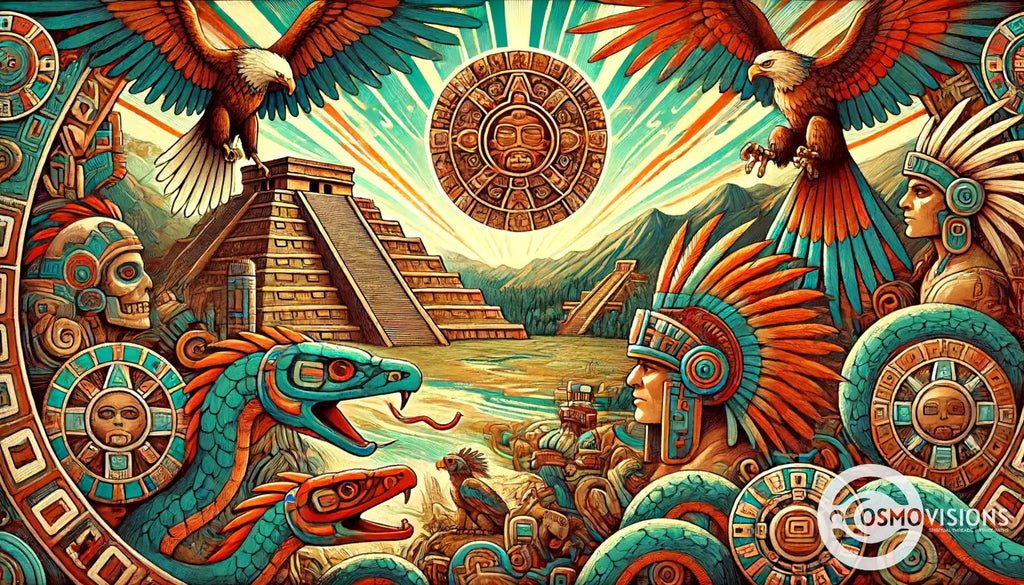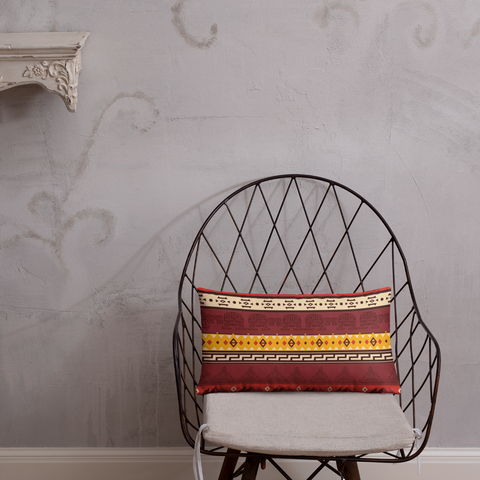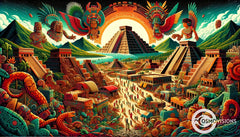Exploring Aztec Architecture: Temples, Pyramids, And The Mesoamerican Legacy
Posted by Massimiliano Geraci

Have you ever wondered about the grand structures of the ancient Aztecs? Their impressive buildings and temples tell stories from centuries ago. Aztec architectural sites, such as Malinalco, Tenayuca, and Templo Mayor, showcase the significance and grandeur of their civilization. One interesting fact is that Aztec architects used volcanic stone in their construction.
This made their structures strong and lasting.
Our article will guide you through the marvels of Aztec architecture. From the towering pyramids to the ingenious urban layout of Tenochtitlán, we’ll explore how these creations reflect Aztec society, beliefs, and advancements in building techniques.
Ready to explore? Keep reading!
Key Takeaways
1. Aztec architects used volcanic stone to build solid and lasting structures, including famous pyramids and temples that showcased their engineering skills and deep religious beliefs.
2. Temples, like the Templo Mayor in Tenochtitlán, were central to Aztec spiritual life. They often featured twin temples on top that symbolized important gods and cosmological concepts.
3. The Great Pyramid of Cholula is the largest monument by volume in the Americas. It reflects the ingenuity of Mesoamerican architecture with its massive size and layered history.
4. Water systems in Tenochtitlán showed advanced engineering. The Aztecs built aqueducts for fresh water and sewage systems for waste removal, highlighting their understanding of urban planning.
5. Aztec buildings aligned with celestial events, demonstrating how deeply cosmology influenced their architecture. This alignment showed respect for gods linked to natural elements like rain and sun.
Iconic Structures of the Aztec Empire
The Aztec Empire built amazing buildings that still awe people today. Their cities had towering pyramids and grand temples, showing their power and skill. The Aztec Temple Square, including the significant Templo Mayor, was a prime example of this, reflecting the competition among Aztec cities to construct the greatest temples in the empire.
Templo Mayor
Templo Mayor stood at the center of Tenochtitlan, exemplifying the great temple Aztec architecture and showcasing the Aztec’s mastery in building. This temple was more than just stones stacked high. It held the face of Tonatiuh, their sun god, right in its heart.
Each layer and carved stone told stories of gods, power, and the skies above. Builders chose it as a place where heaven met earth—a sacred spot for rituals that tied them to celestial events.
This grand structure wasn’t silent; it spoke of fierce battles and quiet prayers. It was a bridge between two worlds—the divine and the mortal. The Aztecs showed their respect with offerings buried deep within its body, making Templo Mayor an open book on their beliefs and artistry.
Moving from this towering symbol of faith, we explore another wonder—the Pyramid of the Sun—showing how these structures echo through time and space in Mesoamerica.
Pyramid of the Sun
The Pyramid of the Sun stands tall in Teotihuacán, a testament to ancient Mesoamerican engineering and spirituality. This grand structure captures the essence of Aztec religious practices and their connection to the cosmos.
Builders chose its location carefully, aligning it with celestial events that marked sacred times on the Aztec calendar. Central to Aztec religion, the pyramid served as a place for offerings, human sacrifice, astronomical observation, and religious festivals, dedicated to various gods from the Aztec pantheon. This monument is not just stone and mortar; it’s a bridge between earth and sky.
At 180 feet high, it towers over the landscape, inviting awe and inquiry. Its base covers enough ground for nearly three football fields side by side. The journey up its many steps leads to two platforms — spaces once alive with ceremonies dedicated to gods controlling life’s most vital elements.
Crafted from stone and adobe bricks, this pyramid was more than an architectural feat; it was a hub for rituals that honored cycles of birth, death, and rebirth amid Mesoamerica’s vast narratives.

Pyramid of the Moon
Moving from the majesty of the Pyramid of the Sun, we journey to its eternal companion in sacred architecture, the Pyramid of the Moon. This striking structure marks another pinnacle of Aztec engineering and spiritual design, standing proudly at the northern end of the city Tenochtitlán.
Crafted with precision and care, this pyramid was a monumental shrine capturing both time’s passage and divine favor.
Builders chose volcanic stone for its construction, showcasing their profound connection to earth’s raw power. They shaped these stones into a grand staircase leading up to twin temples at its summit – spaces dedicated to gods essential to Aztec culture.
Here, ceremonies and offerings occurred under open skies, linking people directly with celestial forces. The Pyramid of the Moon was not just an architectural feat; it was a bridge between humanity and divinity, embodying beliefs deeply rooted in cosmology, astronomy, and religion.

Great Pyramid of Cholula
The Great Pyramid of Cholula is a marvel in Mesoamerican architecture's history. This grand structure is notable not only for its size but also for the layers of cultural significance embedded within it.
Builders used bricks and earth to construct this massive pyramid, making it the largest monument by volume in the Americas. Its base covers more ground than any other building from ancient times. The Great Pyramid of Cholula is a typical Aztec double pyramid, featuring joined pyramidal bases supporting two temples, similar to the most important pyramids in the Aztec empire.
This pyramid served multiple purposes over generations, including religious ceremonies and as a beacon for navigating the spiritual realm. The Aztecs saw it as a vital link between their gods and the earthly domain.
Today, researchers and visitors alike marvel at how such an immense construction was achieved with the technology available during that era. Its design reflects not only impressive engineering skills but also deep religious beliefs, showing how spirituality guided ancient civilizations in creating spaces that connected them with divine forces.
Analyzing Tenochtitlan's Urban Layout
Tenochtitlan’s design showed the Aztecs’ smart planning and deep spiritual beliefs. This grand city was a marvel of architecture and spirit once standing where Mexico City does now.
Its streets and buildings aligned with celestial events, shining light on their cosmos respect. Temples rose high, touching the sky, each stone placed with purpose. Canals ran like veins through the city, bringing life to homes and gardens.
The main plaza buzzed with activity—markets filled with colors and scents from all over the empire. Tenochtitlan's urban design, with its intricate layout and architectural elements, subsequently influenced later Mesoamerican styles.
“Temples were constructed at the top of the pyramids…”
Chinampas dotted around Tenochtitlan fed its people. These floating gardens were an innovative way to farm on lake waters. Craftsmen, traders, warriors—all found a place in this well-laid-out city.
Buildings made from volcanic stone stood strong against time. Each corner of Tenochtitlan reflected its people’s connection to their gods and nature—a true testament to their architectural genius.
Architectural Innovations and Techniques
The Aztecs built strong structures using volcanic rock. Influences from Classic and other Postclassic Mesoamerican people are evident in how Aztec architecture reflects their migration and religious beliefs. They also created smart water systems for their big cities.
Employing Volcanic Stone
Aztec builders used volcanic stone to strengthen their temples and buildings. This hard, long-lasting rock helped them build impressive structures that still amaze people today.
They found this material in the valleys around their city, which made it easy to get.
Crafting these stones required skill. Workers shaped them into blocks for constructing walls and carving intricate designs that told stories or honored gods. These carvings included symbols like fire serpents, Xiuhcoatl, showing the power of rival deities from 1502 to 1520.
Such detailed work shows how Aztecs combined art with architecture.
Next, we explore how they designed complex urban water systems.

Designing Complex Urban Water Systems
The Aztecs engineered sophisticated water systems for their city, Tenochtitlan. They built aqueducts to bring fresh water from springs miles away. This was crucial in a marshy area where clean drinking water wasn't easy to find.
Their engineers also created sewage systems for waste removal, which helped keep the city clean and controlled flooding during rainy seasons.
Next, they constructed causeways with bridges that could be raised or lowered. These connected the island city to the mainland, allowing people and goods to move easily while defending against attacks.
The clever use of natural resources shows how advanced Aztec engineering was. Let's explore more about architectural features and symbolism in Aztec buildings.
Architectural Features and Symbolism
Aztec builders used volcanic rock and detailed carvings to tell stories. Their architecture was characterized by symmetry, geometric designs, and symbolic elements such as animal representations and symbolic painting. Their twin places of worship stood for balance and the universe’s forces.
Twin Temples and Their Significance
Twin temples stood as the heart of Aztec spiritual and communal life. These sacred buildings symbolized the dual nature of their worldview, balancing forces like life and death, war and peace, or fertility and drought.
Crafted from stone, these structures showcased the Aztecs' skill in carving intricate designs that told stories of their gods, heroes, and cosmic battles. Each temple was home to different deities—such as Huitzilopochtli, the sun god and protector of Tenochtitlán, and Tlāloc, the rain deity crucial for agriculture.
In every stone carved, a story; in every temple built, a cosmos reflected.
Important ceremonies unfolded at these twin centers where priests performed rituals to ensure harmony between people and divine forces. Through these practices involving music, dance, offerings—and yes—human sacrifices made through a ceremonial blade known as tecpatl—the community sought favor from their gods to secure rain for crops or victory in battle.
Thus, the twin temples became places not just for religious worship but also for societal gatherings, where beliefs were reinforced through collective participation.
Use of Volcanic Stone and Carvings
Aztecs used volcanic rock for buildings and sculptures. This tough stone lasted many years. Carvers turned these rocks into art depicting gods, myths, and everyday life. Such work let people see stories of their culture and beliefs.
Artists made the Aztec sun stone with these materials too. The sun stone shows 4 Ollin, a sign of new beginnings after destruction. Placed flat in 1875, this piece links to time cycles and renewal ideas in Aztec thought.
Moving forward explores how religion shaped these designs further.
Symbolism and Functionality in Aztec Architecture
Aztec buildings tell stories. They used carvings to show their gods and beliefs.
Religious Significance of Aztec Pyramids
Pyramids in the Aztec world served as more than massive stone structures; they were sacred spaces connecting earth and sky. These towering creations played a crucial role in religious ceremonies, including the awe-inspiring New Fire Ceremony.
Here, priests extinguished old fires across the empire to light anew from a sacrificial victim's chest—a vivid symbol of rebirth and continuity for the Aztec people.
The pyramid itself was not just an architectural feat but a bridge between worlds, where gods and humans interacted.
Each pyramid was a testament to the Aztecs' deep faith and desire to close the gap between mortal beings and deities. The precision in their alignment with celestial events underscored this bond, offering places where heaven touched earth during significant astrological moments.
Through these pyramids, Aztecs sought favor from gods controlling rain, sun, and war to ensure prosperity across their domain.
Reflecting Social Stratification in Urban Design
Aztec cities show us how society was set up. The layout of Tenochtitlan, the Aztec capital city, clearly showed who was important and who was not. Wealthy nobles lived in large homes with courtyards near the city's center.
This place had temples and palaces. Farther away, smaller houses belonged to common people.
The design of these cities wasn't just about where people lived. It also marked their place in society. Big public buildings were spaces where rituals connected everyone to their gods and community.
Yet, this setup made it clear that there were different levels within society, from rulers to ordinary folks.
Influence of Cosmology and Religion on Aztec Architecture
Aztec builders made their temples and pyramids line up with the stars. This showed how much they valued gods and the sky in their designs. Aztec architecture subsequently influenced later Mesoamerican styles, reflecting their religious beliefs in both religious and domestic structures.
Alignment with Celestial Events
Aztec architects shaped their buildings to mark solar and lunar events. They built structures in perfect harmony with the sky's rhythm. The stone at the heart of their calendar showed this deep connection.
It marked four past worlds and our current one, the Fifth Sun. This was more than an artistic choice; it was a profound act of syncing human life with cosmic cycles.
Their temples faced important celestial points, like where the sun rises on the vernal equinox. On these days, shadows and light played across temple stairs or aligned with specific sculptures to signal times for planting or ceremonies.
The face of Tonatiuh, their sun deity, watched from the center of this carefully arranged world—a constant reminder that time itself was a sacred circle they were part of.
Representation of Gods and Mythological Scenes
Temples and pyramids stood tall, painted in eye-catching colors. These ancient structures were canvases for telling stories of gods and legends. Artists carved scenes into stone, showing battles, prayers, life, and death.
They captured tales of rain bringing life to corn and fierce creatures guarding sacred spaces. Each carving, each color, spoke of respect, fear, and love for their deities.
In this world of stone and color, calendars held secrets of time itself. The Sun Stone, a circle filled with carvings, mapped cycles of the cosmos. It showed days not just passing but full of meaning—a guide for farmers, warriors, priests.
People looked at these stones not only to see what would come but to remember the gods moving through sky above them.
The Influence of Aztec Architecture in Mesoamerica
Aztec building styles spread far and wide across Mesoamerica. Their impressive temples and cities influenced many cultures in the area.
Spread of architectural styles across the region
Aztec engineering feats left a mark beyond the valley of Mexico, influencing cities and cultures across Mesoamerica. From the massive pyramids in Tenayuca to the intricate urban designs of Tenochtitlan, their architectural styles spread far.
These grand constructions were not just buildings but symbols of power and religious devotion, showing gods like Quetzalcoatl in stone carvings.
Other societies adopted these styles, adapting them to local needs and traditions. For example, Mayan cities began incorporating Toltec designs into their structures, blending two rich cultures.
This mix created a new wave of architecture that still amazes people today with its complexity and beauty. Aztec stonework techniques reached distant lands through trade networks and conquests, making their style known across wide areas.
FAQs
1. What were Aztec temples like?
Aztec temples, tall and impressive, stood as the heart of their cities. They built these on top of pyramids to be close to the gods. Each temple had two shrines at its peak, one for the rain god and another for different gods.
2. Why was Tenochtitlan important in Aztec architecture?
Tenochtitlan, now buried under Mexico City, was once a grand capital with amazing, brightly colored buildings. It had huge courtyards and special places for sports and ceremonies.
3. Did Aztecs build more than just temples?
Yes! In addition to temples, they created homes, pleasure palaces, ball courts for games, and skull racks for display. Their city designs included big plazas where people gathered.
4. How did the Spanish conquest affect Aztec buildings?
When Spain conquered the Aztecs in 1521, many beautiful structures were destroyed or lost. But some survived or have been discovered again through archaeology.
5. Can you find examples of Aztec architecture today?
Some famous remains, like the Templo Mayor in Mexico City or the warrior sculptures at Malinalco, can still be seen today.
6. How do we learn about Aztec art and buildings now?
We study ancient texts written down after the conquest and look at artifacts in museums like the National Museum of Anthropology to understand their impressive architecture and detailed art.






















